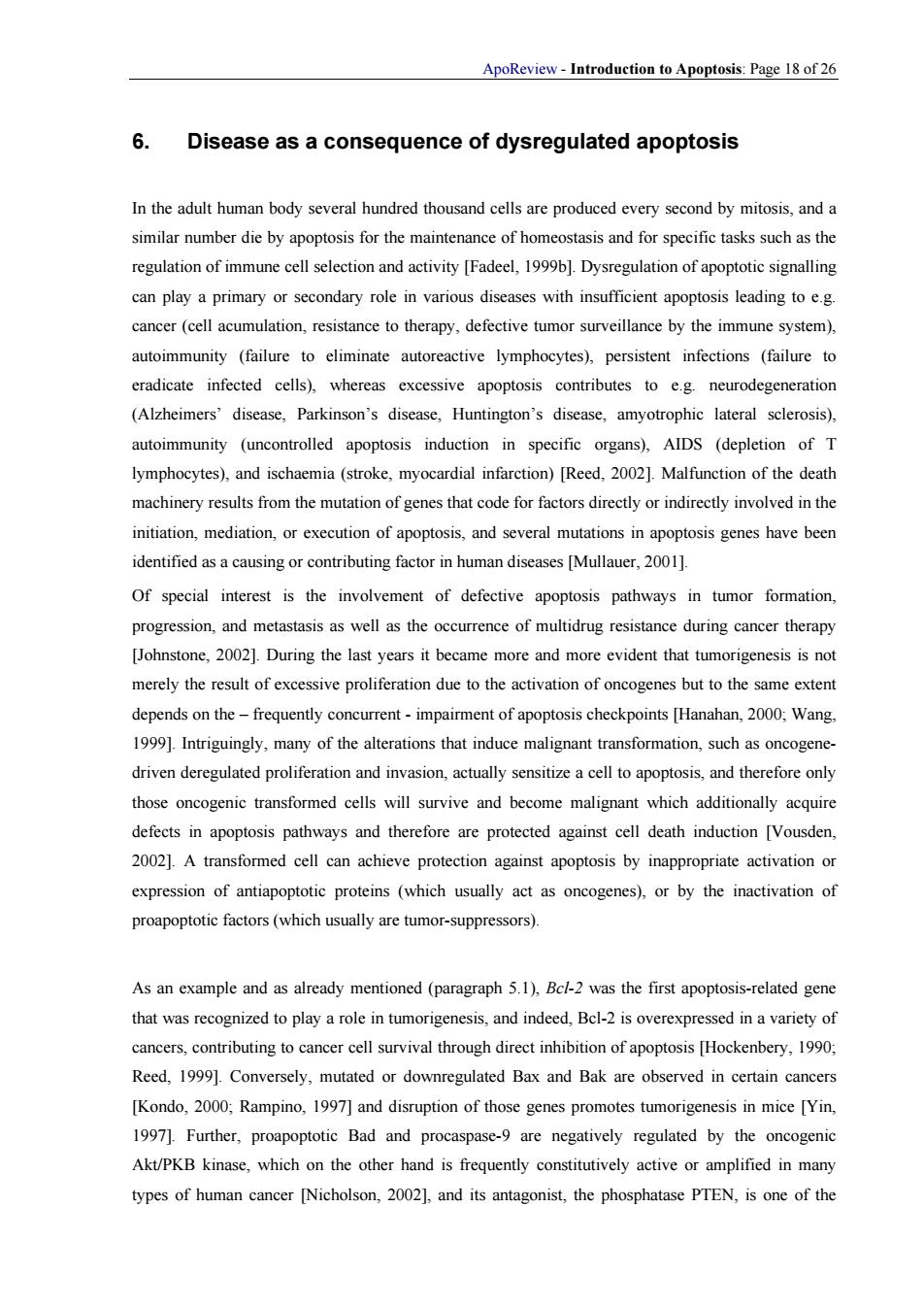正在加载图片...

ApoReview-Introduction to Apoptosis:Page 18 of 26 6. Disease as a consequence of dysregulated apoptosis In the adult human body several hundred thousand cells are produced every second by mitosis,and a similar number die by apoptosis for the maintenance of homeostasis and for specific tasks such as the regulation of immune cell selection and activity [Fadeel,1999b].Dysregulation of apoptotic signalling can play a primary or secondary role in various diseases with insufficient apoptosis leading to e.g. cancer(cell acumulation,resistanceto therapy,defective tumor surveillance by themmune system). autoimmunity (failure to eliminate autoreactive lymphocytes).persistent infections (failure to eradicate infected cells),whereas excessive apoptosis contributes to e.g.neurodegeneration (Alzheimers'disease.Parkinson's disease,Huntington's disease,amyotrophic lateral sclerosis). autoimmunity (uncontrolled apoptosis induction in specific organs).AIDS (depletion of T lymphocytes),and ischaemia (stroke,myocardial infarction)[Reed,2002].Malfunction of the death machinery result from the mutation of genes that code for factors directy or indirectly involved in the initiation,mediation.or execution of apoptosis,and several mutations in apoptosis genes have been identified asacausingo contributing factor in human diseases [Mullauer,01] Of special interest is the involvement of defective apoptosis pathways in tumor formation. progression,and metastasis as well as the of multidrug resistance during cancer therapy [Johnstone,2002].During the last years it became more and more evident that tumorigenesis is not merely the result of excessive proliferation due to the activation of oncogenes but to the same extent dependson the-frequently of apoptosis checkpoints [Hanahan,. 1999].Intriguingly.many of the alterations that induce malignant transformation,such as oncogene- driven deregulated proliferation and invasion,actually sensitize a cell to apoptosis,and therefore only those oncogenic transformed cells will survive and become malignant which additionally acquire defects in apoptosis pathways and therefore are protected against cell death induction [Vousden, 202 transformed cell can achieve protection against apoptosis by inappropriate activationo expression of antiapoptotic proteins(which usually act as oncogenes),or by the inactivation of proapoptotic factors(which usually are tumor-suppressors). As an example and as already mentioned (paragraph 5.1),Bcl-2 was the first apoptosis-related gene that was recognized to play arole in tumorigenesis,and indeed,Bel-2 is overexpressed in a variety of cancers,contributing to cancer cell survival through direct inhibition of apoptosis [Hockenbery.1990. Reed,1999].Conversely,mutated or downregulated Bax and Bak are observed in certain cancers [Kondo,2000:Rampino,1997]and disruption of those genes promotes tumorigenesis in mice [Yin, 1997].Further,proapoptotic Bad and procaspase-9 are negatively regulated by the oncogenic Akt/PKB kinase,which on the other hand is frequently constitutively active or amplified in many types of human cancer [Nicholson,2002]and its antagonist,the phosphatase PTEN,is one of the ApoReview - Introduction to Apoptosis: Page 18 of 26 6. Disease as a consequence of dysregulated apoptosis In the adult human body several hundred thousand cells are produced every second by mitosis, and a similar number die by apoptosis for the maintenance of homeostasis and for specific tasks such as the regulation of immune cell selection and activity [Fadeel, 1999b]. Dysregulation of apoptotic signalling can play a primary or secondary role in various diseases with insufficient apoptosis leading to e.g. cancer (cell acumulation, resistance to therapy, defective tumor surveillance by the immune system), autoimmunity (failure to eliminate autoreactive lymphocytes), persistent infections (failure to eradicate infected cells), whereas excessive apoptosis contributes to e.g. neurodegeneration (Alzheimers’ disease, Parkinson’s disease, Huntington’s disease, amyotrophic lateral sclerosis), autoimmunity (uncontrolled apoptosis induction in specific organs), AIDS (depletion of T lymphocytes), and ischaemia (stroke, myocardial infarction) [Reed, 2002]. Malfunction of the death machinery results from the mutation of genes that code for factors directly or indirectly involved in the initiation, mediation, or execution of apoptosis, and several mutations in apoptosis genes have been identified as a causing or contributing factor in human diseases [Mullauer, 2001]. Of special interest is the involvement of defective apoptosis pathways in tumor formation, progression, and metastasis as well as the occurrence of multidrug resistance during cancer therapy [Johnstone, 2002]. During the last years it became more and more evident that tumorigenesis is not merely the result of excessive proliferation due to the activation of oncogenes but to the same extent depends on the – frequently concurrent - impairment of apoptosis checkpoints [Hanahan, 2000; Wang, 1999]. Intriguingly, many of the alterations that induce malignant transformation, such as oncogenedriven deregulated proliferation and invasion, actually sensitize a cell to apoptosis, and therefore only those oncogenic transformed cells will survive and become malignant which additionally acquire defects in apoptosis pathways and therefore are protected against cell death induction [Vousden, 2002]. A transformed cell can achieve protection against apoptosis by inappropriate activation or expression of antiapoptotic proteins (which usually act as oncogenes), or by the inactivation of proapoptotic factors (which usually are tumor-suppressors). As an example and as already mentioned (paragraph 5.1), Bcl-2 was the first apoptosis-related gene that was recognized to play a role in tumorigenesis, and indeed, Bcl-2 is overexpressed in a variety of cancers, contributing to cancer cell survival through direct inhibition of apoptosis [Hockenbery, 1990; Reed, 1999]. Conversely, mutated or downregulated Bax and Bak are observed in certain cancers [Kondo, 2000; Rampino, 1997] and disruption of those genes promotes tumorigenesis in mice [Yin, 1997]. Further, proapoptotic Bad and procaspase-9 are negatively regulated by the oncogenic Akt/PKB kinase, which on the other hand is frequently constitutively active or amplified in many types of human cancer [Nicholson, 2002], and its antagonist, the phosphatase PTEN, is one of the